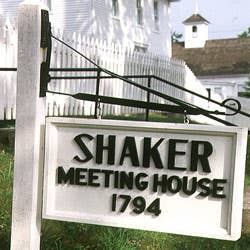
A Short History of the Shakers
The United Society of Believers, commonly called the Shakers—for the trembling and shaking that its worshipers engaged in during prayer—was one of the many unconventional Protestant religious groups that emerged in England during the latter half of the 18th century. Founded in the industrial city of Manchester by James Wardley and his wife, Jane, the movement was popularized by an illiterate textile worker named Ann Lee, a tall, striking, charismatic woman who became involved with the Shakers in 1758 and spread their teachings, frequently incurring local hostility. In 1774, Lee led a small group of Believers to America—guided, according to Shaker lore, by a vision. They settled in Niskeyuna, in what is now Watervliet, near Albany, in upstate New York, and Lee became known as Mother Ann. Her followers held that God had both a male and a female spirit and that Mother Ann was that female entity—the second incarnation of Christ. By the time of Mother Ann's death, in 1784, the Shaker community numbered more than 1,000 converts.
Shaker influence grew in America in subsequent decades. Soon after Mother Ann's death, two of her followers, Joseph Meacham and Lucy Wright, took over leadership of the group, developing its organizational structure and its spiritual hierarchy and establishing the first formal Shaker village— in New Lebanon, New York, in 1785.
The Shaker movement was particularly attractive to large American families, who were drawn by the religious principles, the self-contained lifestyle, and, in some cases at least, the fact that women enjoyed equal status with men within the community. Everyone was welcome as long as he or she adhered to the Shaker tenets, which included celibacy, open confession of sins, common ownership of property, separation from the outside world, and a strong work ethic. Shakerism spread through New England and west and south to Indiana, Ohio, and Kentucky. By the 1840s, the Shakers were at the height of their popularity, with more than 4,000 Believers living in 16 communities in eight states. In the mid-1800s, with fewer families joining the ranks, the Shakers began absorbing hundreds of orphans, many of whom chose to remain in the community as adults.
To the outside world, the Shakers became known not so much for their religious beliefs as for their elegant, simple approach to design. They were celebrated for their model farms, orderly communities, furniture, decorative arts, and architecture— and for their many inventions, which included the automatic washing machine, the circular saw, the apple corer, the common wooden clothespin, and the automatic spring.
By the late1800s, however, the Shaker movement had begun to fall apart. Members found themselves increasingly pulled into the modern world. The wholesale establishment of government-run orphanages after the Civil War robbed the celibate Shakers of their principal means of replenishing their ranks. The population began to age and decline; by 1947 only three communities remained.
Today, the only working Shaker community left is at Sabbathday Lake, in New Gloucester, Maine. Founded in 1783, the village once housed more than 170 Believers; today there are eight, ranging in age from 32 to 81. Led by Sister Frances Carr and Brother Arnold Hadd, the community is intent on continuing the Shaker legacy. To that end, members of the community no longer turn their backs on the world as their predecessors did: they lecture at local schools, write a quarterly newsletter, maintain a website, and continue to accept newcomers; two joined this past year.
Keep Reading
Continue to Next Story










